The Sculptor Pinwheel Galaxy is a bright spiral galaxy located approximately 6.07 million light-years away in the southern constellation Sculptor. With an apparent magnitude of 9.0 and angular size of 21.9 by 15.5 arcminutes, it can be observed in small and medium telescopes. The galaxy is catalogued as NGC 300 in the New General Catalogue and Caldwell 72 (C72) in the Caldwell catalogue of deep sky objects visible in amateur telescopes.
The Sculptor Pinwheel Galaxy appears nearly face-on. It is inclined 42° from our point of view. It appears similar to the brighter and larger Triangulum Galaxy (M33) in the northern constellation of Triangulum, as well as to the intermediate spiral galaxy NGC 2403 in Camelopardalis. Observations with the Hubble Space Telescope (HST) have revealed many young, blue star clusters and active star-forming regions in the galaxy’s spiral arms.
NGC 300 is one of the nearest galaxies to the Local Group, the home of our own Milky Way galaxy. The Sculptor Pinwheel is believed to lie between the Local Group and the Sculptor Group, which includes the bright Sculptor Galaxy (NGC 253), the Claw Galaxy (NGC 247), the Sculptor Dwarf, and a number of other galaxies that appear in the same region of the sky.

Colour-composite image of the nearby spiral galaxy NGC 300 and the surrounding sky field, obtained in 1999 and 2000 with the Wide-Field Imager (WFI) on the MPG/ESO 2.2-m telescope at the La Silla Observatory. Image credit: ESO (CC BY 4.0)
The Sculptor Pinwheel forms a gravitationally bound pair with the Magellanic type barred spiral galaxy NGC 55 (the String of Pearls Galaxy or Whale Galaxy). Both galaxies can be seen in a small telescope. NGC 55 is brighter, with an apparent magnitude of 7.87, but appears edge-on. It is listed as Caldwell 72 in the Caldwell catalogue. It appears around 8 degrees west of NGC 300.
The ultra-faint dwarf galaxy Sculptor C, which lies 6.65 million light-years away, is believed to be a satellite of NGC 300.
In 2022, observations with the Multi Unit Spectroscopic Explorer (MUSE) on the Very Large Telescope (VLT) in the Atacama Desert of Chile led to the detection of 107 planetary nebulae in NGC 300. Astronomers derived a distance of 1.98 megaparsecs (6.46 Mly) based on the planetary nebula luminosity function (PNLF).
In 2025, deep optical observations of the stellar halo of NGC 300 as part of the DECam Local Volume Exploration Survey (DELVE) revealed a large stellar stream extending over 130,463 light-years (40 kpc) north from the galaxy’s centre. A team of astronomers led by Catherine E. Fielder, Steward Observatory, University of Arizona, identified other halo structures and streams that strongly suggest that the galaxy accreted a smaller neighbour in the past.
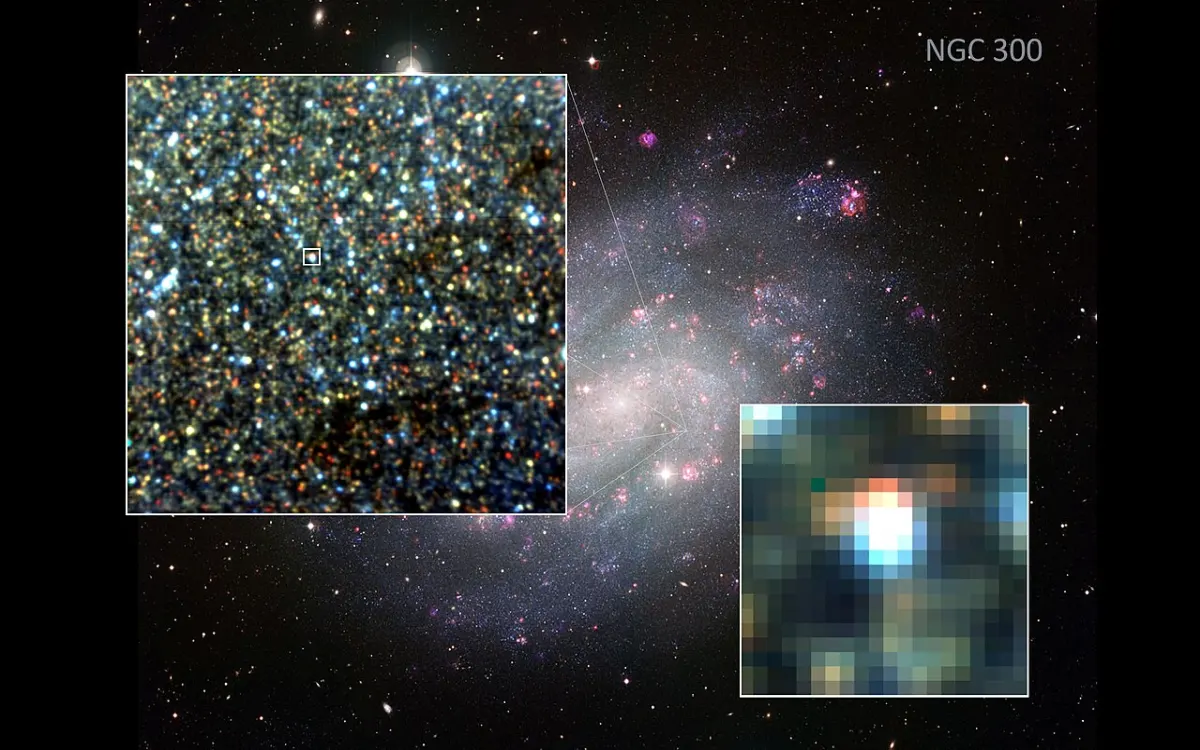
MUSE images of NGC 300 laid over a Wide Field Imager image, with individual stars clearly visible. Credit: ESO (CC BY 4.0)
Facts
NGC 300 was discovered by the Scottish astronomer James Dunlop on August 5, 1826. Dunlop observed the galaxy with his 9-inch speculum reflector at the Paramatta Observatory (now Parramatta) in New South Wales, Australia. At the time, the true nature of the object was unknown. Dunlop described it as a “pretty large faint nebula, irregular round figure, 6′ or 7′ diameter, easily resolvable into exceedingly minute stars, with four or five stars of more considerable magnitude; slight compression of stars to the centre.”
British astronomer John Herschel observed NGC 300 from South Africa in September 1834 and catalogued it as h 2359. He later included the “nebula” in his General Catalogue as GC 169. Danish astronomer John Louis Emil Dreyer listed the object as NGC 300 in his New General Catalogue (1888).
The Sculptor Pinwheel Galaxy and the nearby String of Pearls Galaxy (NGC 55) were long believed to be members of the Sculptor Group. However, more recent studies have placed the two galaxies much closer to us. NGC 55 lies 6.5 million light-years away, while the Sculptor Galaxy (NGC 253), which lies at the centre of the Sculptor Group, lies 11.4 million light-years away.
NGC 300 is not the only pinwheel in the sky. Others include the famous Pinwheel Galaxy (Messier 101) in the region of the Big Dipper in Ursa Major, the Little Pinwheel Galaxy (NGC 3184) in the region of the Great Bear’s feet, the Southern Pinwheel Galaxy (Messier 83) in Hydra, and the Coma Pinwheel (Messier 99) in Coma Berenices. Most of these galaxies can be spotted in small telescopes in good conditions.
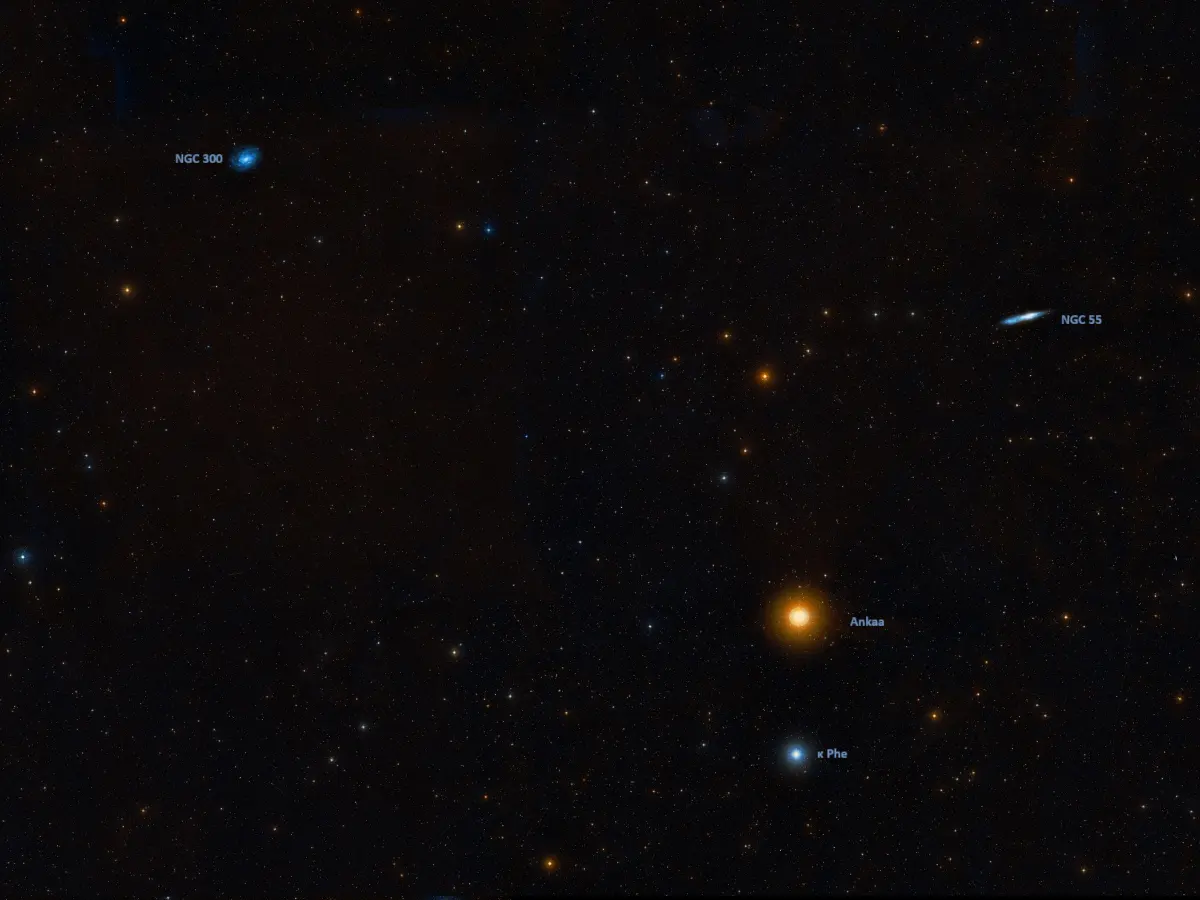
NGC 300, NGC 55 and Ankaa, image credit: ESO/Digitized Sky Survey 2 (CC BY 4.0)
Location
The Sculptor Pinwheel Galaxy lies in the southern portion of the constellation Sculptor, near the border with Phoenix. The nearest bright star to the galaxy is Ankaa (Alpha Phoenicis), the brightest star in Phoenix.
At declination −37° 41′, NGC 300 is best seen from the southern hemisphere. The galaxy never rises above the horizon for observers north of the latitude 52° N and only appears very low in the sky from mid-northern latitudes.
The best time of the year to observe the Sculptor Pinwheel Galaxy and other deep sky objects in Sculptor is during the month of November, when the constellation appears higher above the horizon in the early evening.
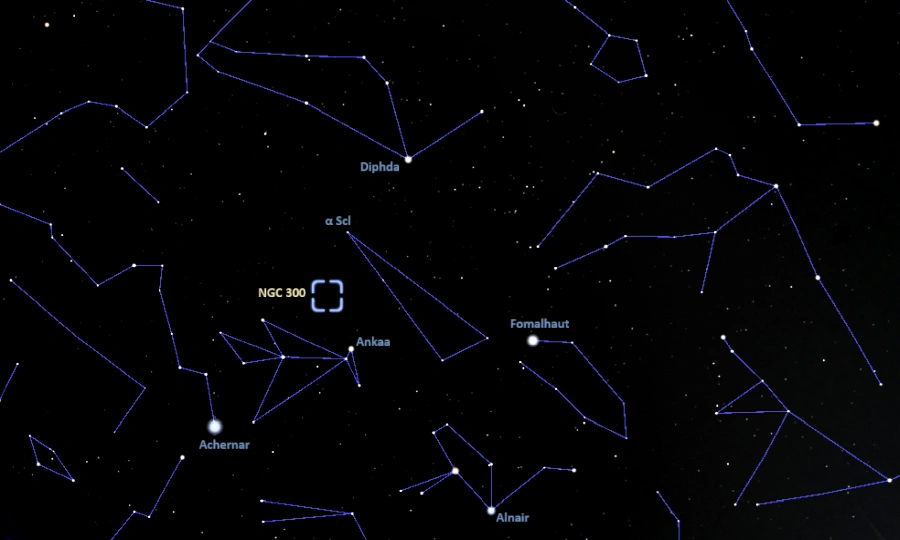
Location of the Sculptor Pinwheel Galaxy (NGC 300), image credit: Stellarium
Sculptor Pinwheel Galaxy – NGC 300
| Constellation | Sculptor |
| Object type | Spiral galaxy |
| Morphological type | SA(s)d or Sc D |
| Right ascension | 00h 54m 53.4465638304s |
| Declination | −37° 41′ 03.168402396″ |
| Apparent magnitude | 9.0 |
| Apparent size | 21.9′ × 15.5′ |
| Distance | 6.07 ± 0.23 million light-years (1.86 ± 0.07 megaparsecs) |
| Redshift | 0.000487 ± 0.000007 |
| Heliocentric radial velocity | 146 ± 2.0 km/s |
| Size | 55,200 light years (16.92 kiloparsecs) |
| Mass | (2.9 ± 0.2) × 1010 M☉ |
| Names and designations | Sculptor Pinwheel Galaxy, NGC 300, Caldwell 72, C72, LEDA 3238, PGC 3238, ESO 295-20, ESO 295- G 020, ESO-LV 295-0200, MCG -06-03-005, IRAS 00525-3757, 2MASX J00545347-3741037, AM 0052-375, SGC 005232-3757.2, HIPASS J0054-37, LVHIS 005, SPB 17, 6dFGS gJ005453.4-374104, 6dFGS gJ005454.9-374107, [CHM2007] LDC 26 J005453.47-3741037, [M98c] 005232.0-375712, [VDD93] 3, Gaia DR2 5001350950743544192, Gaia DR3 5001350950743544192 |
Images
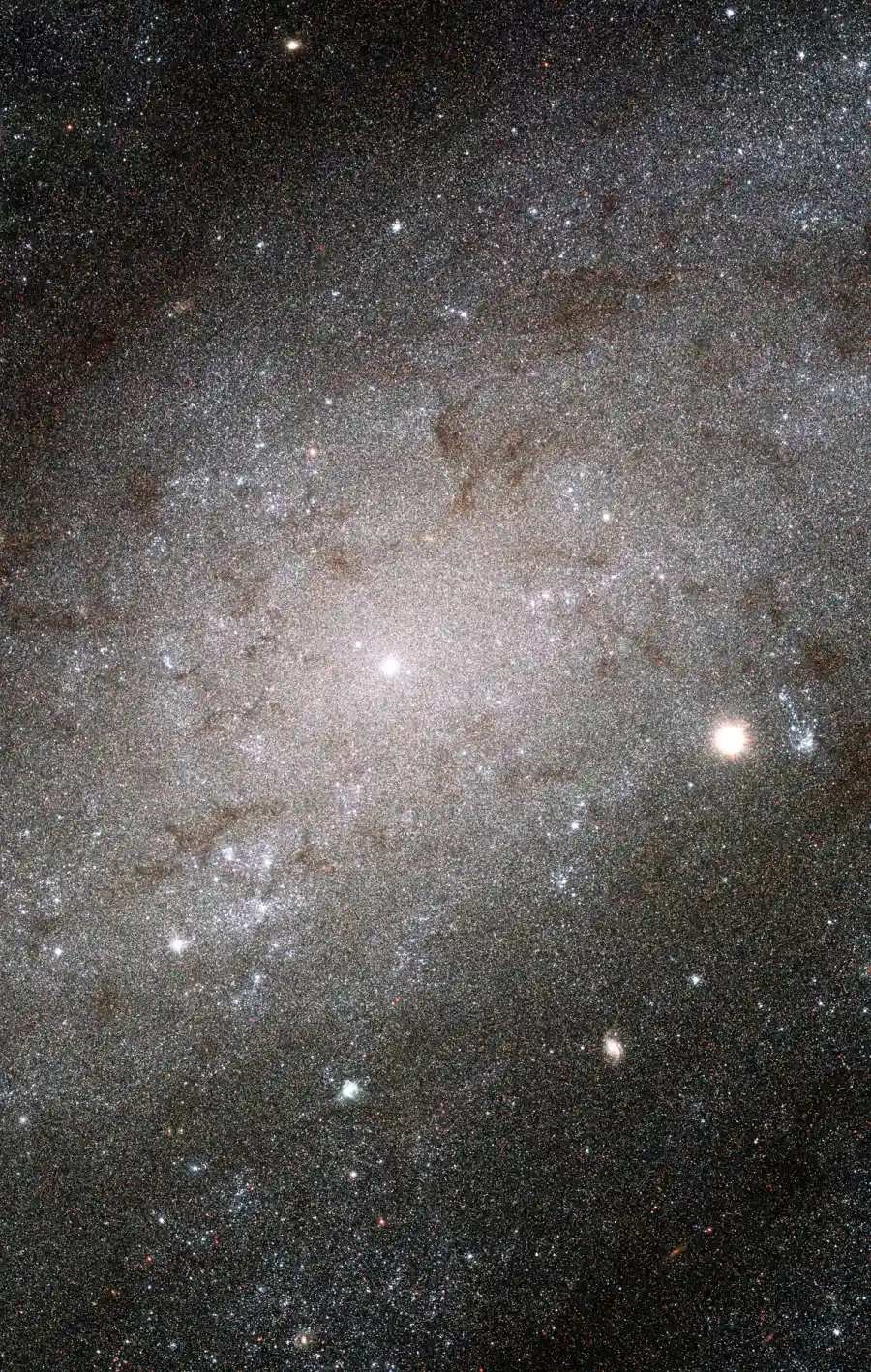
What resemble grains of sand in this Hubble image are actually individual stars embedded deep in the heart of the nearby spiral galaxy Caldwell 70. Hubble’s exquisite resolution allows us to see the galaxy’s stars as distinct points of light, despite the fact that the galaxy is about 6 million light-years away. Caldwell 70 has sweeping blue spiral arms with vigorous star formation throughout. The inner region of the galaxy, an area spanning about 7,500 light-years, is pictured here. At the center is the galaxy’s bright, densely packed core surrounded by tendrils of dark dust meandering among the stars in the galactic plane. While Caldwell 70 is one of the Milky Way’s closest galactic neighbors, it’s so far away that only the brightest stars can be picked out in ground-based telescopes. With a magnitude of 8.1, the galaxy can be seen through a small telescope, but don’t expect to see an image like this one! With a resolution some 10 to 20 times better than ground-based telescopes, Hubble’s Advanced Camera for Surveys resolves many more stars in this galaxy than can be detected from the ground. Hubble’s unique ability to distinguish so many stars in Caldwell 70 helped astronomers test a new technique for measuring distances to other galaxies using blue supergiant stars and compare that technique to more traditional measurement methods. Discovered from Australia by Scottish astronomer James Dunlop in 1826, Caldwell 70 appears low in the autumn sky in the Northern Hemisphere but is best viewed in the springtime from the Southern Hemisphere. Caldwell 70 spans nearly the same amount of sky as the full moon. Image credit: ESA/NASA/Hubble (CC BY 2.0)
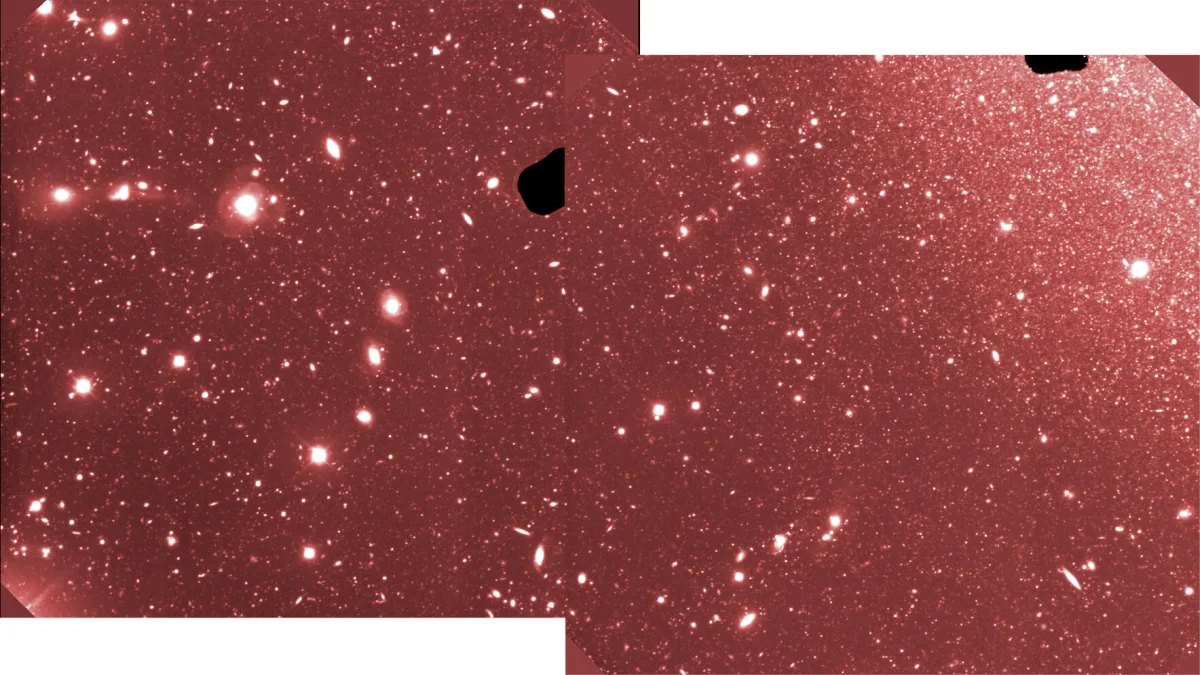
Gemini GMOS deep-field of NGC 300 revealing individual stars down to about magnitude 27 (3 sigma) in two r-band images that each have a combined exposure/integration of 8,100 seconds (2.25 hours). Close examination also reveals that this image contains thousands of individual distant galaxies well beyond NGC 300. Credit: Gemini Observatory (CC BY 4.0)

Sometimes, the best way to understand how something works is to take it apart. The same is true for galaxies like NGC 300, which NASA’s Spitzer Space Telescope has divided into its various parts. This image taken by the infrared array camera on Spitzer readily distinguishes the main star component of the galaxy (blue) from its dusty spiral arms (red). The star distribution peaks strongly in the central bulge where older stars congregate, and tapers off along the arms where younger stars reside. Thanks to Spitzer’s unique ability to sense the heat or infrared emission from dust, astronomers can now clearly trace the embedded dust structures within NGC 300’s arms. When viewed at visible wavelengths, the galaxy’s dust appears as dark lanes, largely overwhelmed by bright starlight. With Spitzer, the dust — in particular organic compounds called polycyclic aromatic hydrocarbons — can be seen in vivid detail (red). These organic molecules are produced, along with heavy elements, by the stellar nurseries that pepper the arms. The findings provide a better understanding of spiral galaxy mechanics and, in the future, will help decipher more distant galaxies, whose individual components cannot be resolved. Credit: NASA/JPL-Caltech/G. Helou (Caltech) (PD)
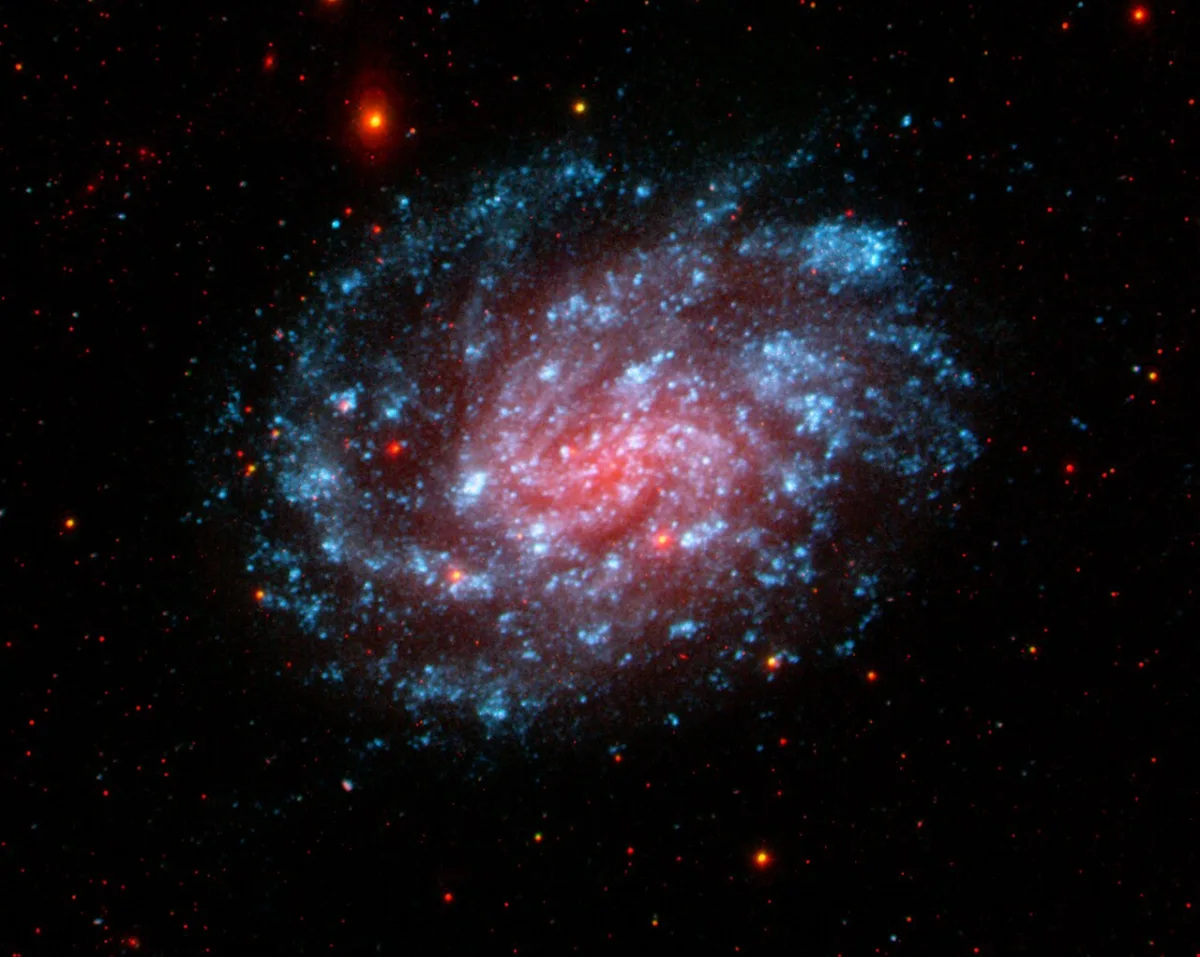
This image from NASA’s Galaxy Evolution Explorer shows the galaxy NGC 300, located in the constellation Sculptor. It is a classic spiral galaxy with open arms and vigorous star formation throughout. Blue represents ultraviolet light captured by the telescope’s long-wavelength detector. Green shows ultraviolet light from the short-wavelength detector, and red shows red visible light from the Las Campanas Observatory, Chile. Image credit: NASA/JPL-Caltech/Las Campanas (PD)

Stars in the spiral galaxy NGC 300, image credit: F. Bresolin (Institute for Astronomy, U. Hawaii) and the Digitized Sky Survey (PD)

Astronomers using ESO’s Very Large Telescope (VLT) have detected a stellar-mass black hole much further away than any other previously known. With a mass about twenty times that of the Sun, this is also the second most massive stellar-mass black hole ever found. The newly announced black hole lies in a spiral galaxy called NGC 300, six million light-years from Earth. This image composite shows the spectacular spiral galaxy NGC 300 as seen in an image from the Digitized Sky Survey 2 (DSS2), as well as the position of the stellar-mass black hole in the galaxy in an image obtained with the FORS2 instrument on the VLT. Credit: ESO/ Digitized Sky Survey 2/P. Crowther (CC BY 4.0)

Sculptor Pinwheel Galaxy, image credit: Pablo Carlos Budassi (CC BY-SA 4.0)